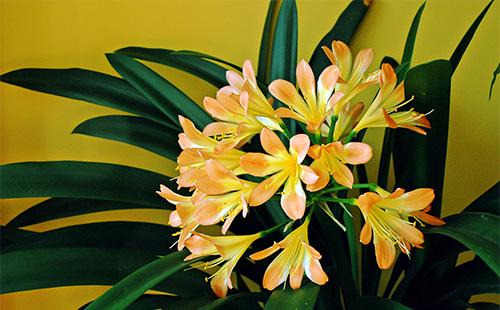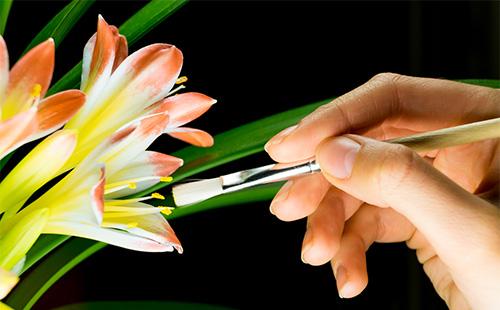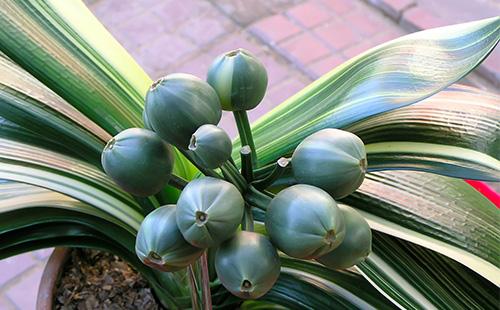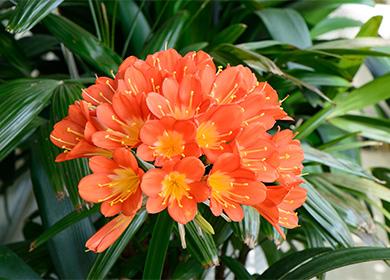The content of the article
South Africa is considered the birthplace of Kaffir lily. And more precisely - its western coast. This plant cannot boast of diversity. There are only three main types of Kaffir lily. Two of them - cinnabar and noble (she is beautiful) - have taken root well in our latitudes. In winter, the African shy prefers cool and spacious rooms with lots of air. That is why Clivia is a frequent resident of cool and bright school classes and municipal offices. In addition, she is completely unpretentious and requires only one thing - so that she is not disturbed.
Relatives of clivia are hippeastrum and amaryllis, which also belong to the amaryllis family. In favorable and comfortable conditions, Kaffir lily is able to live about 40-50 years. On well-groomed plants "aged" appears about fifty flowers of yellow-coral color.
Types of African centenarians
In science, clivia is called an evergreen stemless plant. Its leaves are shaped like a sword. A peduncle, having ribbed edges, combines from 15 to 50 inflorescences. Clivia flowers bloom one by one. Therefore, the flowering period of Kaffir lily is quite long - up to 21 days. Owner reviews confirm: a caring grower has an African centenarian capable of blooming several times a season. The features of different types can be found in the table.
Table - Types of clivia and their features
| View | Flowering period | Features |
|---|---|---|
| Cinnabar | - February - May | - Leaves up to 50 cm; - flower stalk up to 50 cm; - coral-orange flowers with a yellow base |
| Beautiful | - February - May | - Leaves up to 30 cm; - peduncle from 30 to 50 cm; - elongated flowers of light coral color |
| Gardena | - winter months | - Leaves up to 50 cm; - flower stalk up to 45 cm; - bells with coral color |
Selective varieties of cinnabar clivia are a few additional varieties of the evergreen. The color of the leaves and the height of the home flowers may vary depending on the variety.

Clivia Care: Basic Rules
Clivia likes to look at the East and the West. Therefore, the eastern and western windows are considered the ideal location for the evergreen tikhoni. It is better to protect clivia from direct rays of the sun. She feels great in the depths of a bright room. For example, on a computer desk or bookcase. The following five recommendations will help ensure cleavia is well-deserved.
- Air temperature. Caring for clivia in a pot begins with creating the most comfortable temperature conditions for the plant. An African centenarian is able to endure heat, but in summer, moderate temperatures in the range from 24 to 27 ° C are considered optimal for her. In the cold season, Kaffir lily craves coolness. The ideal winter temperature should not exceed 15 ° C.
- Humidity. Clivia does not like dryness, but she does not need excessive moisture. If the column of the hygrometer varies between 50-60%, this will be quite enough for the flower.
- Watering. In the period from the beginning of spring to the end of autumn, clivia should be watered quite often, focusing on the drying of the upper soil layer. As soon as the peduncle reaches a height of 15 cm (and this happens just in the middle of autumn), with abundant watering, you can round off. In winter, spraying replaces the watering can, providing sufficient soil moisture without busting.
- Fertilizer. The cultivation of clivia at home is impossible without periodic plant nutrition. In the frosty season, the African centenarian does not need fertilizer. And in the summer, feeding is recommended to be done about once a month. For this purpose, a traditional fertilizer designed for flowering representatives of the flora living on the windowsill is perfect.
- Care after flowering. A faded plant should continue to be regularly watered and fed. Knowing how to care for clivia after flowering, you can easily achieve the reappearance of the peduncle.
Transplant Features
Do not rush to transplant clivia into a more spacious tub. Kafra lily most likely feels great in a miniature "container".
A gardener who knows how to care for clivia knows: the ideal pot for her is one in which the root system barely fits. Sometimes, after transplanting, gardeners wonder why clivia does not bloom. Too spacious a pot is one of the common reasons for the lack of flowering. Therefore, it is better not to touch the African quiet at all. And if it is very necessary, the plant should be transplanted shallow. The root neck of the flower should breathe fresh air. Otherwise, the leaf plate may rot, and the plant will have to be urgently resuscitated.

Reproduction: 2 ways
If you want to propagate an evergreen centenarian, use one of two methods available to the grower. Clivia can be propagated independently vegetatively or by seed.
Cuttings
Features. Separation of children from the mother plant is necessary only when the number of leaf plates on them will be four or more.
Action algorithm
- We prepare soil from sand and perlite in a ratio of 1: 1.
- We plant the cuttings in separate small pots.
- Water very moderately.
Seeds
Features. The seed method is the ability to plant clivia without leaves. Kaffir lily seeds can be purchased at a garden center or flower shop, or can be obtained independently by manually pollinating a houseplant. But the florist must know that the appearance of the ovary and the subsequent ripening of the fruits adversely affect the health of clivia and often cause partial depletion of the pet.
Action algorithm
- We take a wide shallow pallet for soil.
- Pour into it a mixture of sand and peat, prepared in a ratio of 1: 1.
- We plant seeds of Kaffir lily to a depth of 1 cm. In this case, the distance between them should not exceed 1.5-2 cm.
- We are waiting for the appearance of the first full leaf and boldly root each sprout in a separate pot.

What is sick and who is afraid of Kaffir lily
Like any houseplant, clivia has its own enemies. The most common pests are mealybugs and scale shield. Diseases affecting the Kaffir lily, as a rule, develop due to mistakes made in caring for the plant. For more information on symptoms and treatment methods, see the following table.
Table - Diseases and pests of clivia, treatment methods
| Pest / disease | Symptoms of lesion | Treatment methods |
|---|---|---|
| Shield | - Dry and fall leaves; - brown plaques appear on the leaf plate | - Mechanical cleaning of sheet plates with a soft sponge and soap solution; - spraying with a weak (0.15%) solution of Actellik. |
| Mealybugs | At clivia leaves turn yellow and quickly fall; - the plant is exhausted and dies | - Mechanical cleaning of sheet plates with a soft sponge and soap solution; - warm shower; - in a critical situation - spraying with a weak (0.15%) solution of Actellik |
| Brown spots on the edges of the sheet plate | - Waterlogging | - Temporary cessation of watering; - establishing the correct moisturizing regime |
| Peduncle shortening | - Too cold air at the time of flowering; - insufficient watering | - Providing a flowering plant with proper temperature conditions; - resumption of quality watering |
| The appearance of white spots on a sheet plate | - Sunburn | - Protection from direct rays of the sun by changing the location; - dying leaves should be carefully cut |
| Prolonged absence of peduncle | - Lack of sunlight; - too high room temperature | - Recovery of temperature conditions; - change the location of the pot to a more comfortable one; - temporary irrigation with warm water 37-40 ° C |
| Leaf fading | - Lack of minerals and vitamins in the root system | - Kaffir Lily Fertilizer |
Surprisingly, some African tribes still use pure clivia juice for medicinal purposes. It is given in various proportions and quantity to the patient, and thereby eliminate the symptoms of fever, facilitate labor and neutralize the effects of creeping reptiles, which are a dime a dozen in the tropics. We, however, do not need the knowledge of African healers. But the information on how to care for clivia will certainly come in handy. Especially for those who dream to grow their own meek and captivating tropical beauty in their own home.
Reviews: “An extremely unpretentious plant ... but does not like it when it is often moved from place to place”
Clivia is often confused with amaryllis, hyperarum. It is very simple to distinguish, clivia does not have a bulb. In my opinion, it is an extremely unpretentious plant, does not have a rest period, like many bulbous. Frequent residents of our district clinics, kindergartens, schools and other public places. the cleaning services of the cleaning lady are quite enough, if only the dust from the leaves is wiped. The Dutch varieties are very original, but, in my opinion, unreasonably expensive.
Vladislav Larionov, http://www.botanichka.ru/blog/2010/02/11/clivia/
It always starts to bloom at first inside the leaves, and I do not push the leaves apart, everything goes naturally, then the arrow rises higher and higher. For three years it bloomed on March 8, in May for my doctor’s and in October for my husband’s birthday.This year, all of March and until mid-April bloomed. I went to crop the arrow, and there still new flowers appeared, there will be a second arrow. I first sprayed water (0.5l) with hydrogen peroxide (1 tbsp. Spoon). For three years I have not fed anything to my flower, I only water it and blooms three times a year.
Clara, http://flowertimes.ru/kliviya/
Good friends gave me clivia for my birthday. I love indoor flowers. I try to choose the conditions necessary for him, to provide the necessary watering and fertilizer. And, of course, having received clivia, I began to look for information on caring for this plant. It turned out that the flower is extremely unpretentious, and subject to all the rules of care, blooms twice a year. It pleases))) It always has been (and I have already had a flower for 6 years), but this year, 2012, my clivia blossoms 3rd !!!! time. Apparently, she really likes me! Clivia does not like being often moved from place to place. In winter I put the flower pot on the windowsill (nowhere else), put it on the glazed balcony in the spring, and cover the windows next to the flower with straw shutters. So direct sunlight does not fall on the leaves. It remains only to provide watering and spraying of leaves. If the flower is comfortable, then it releases a long arrow, on which then beautiful red-orange bells open. Now just my clivia is going to please me and my family))
KittenKate, http://otzovik.com/review_232380.html

